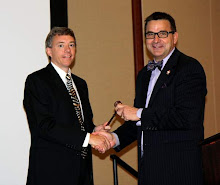Guest Blogger.. A Students View
Hi everyone! My name is Lindsey Parker and I am a third
year student from the Pennsylvania College of Optometry. I'm currently a
student extern at Dr. John Burns' office in Clinton, MD. I've taken over his blog this week to provide
some insight into my first month here at Eye Design. My first few days
were all about learning the EHR software and dusting off my clinical skills
after a two-month hiatus from patient care. In addition to seeing patients,
my extern experience has also included lobbying for an important optometric
bill and becoming a patient myself.
Stepping
out of the office this past week, I had the opportunity to witness the
legislative side of optometry by traveling with Dr. Burns to the Maryland House
of Delegates in Annapolis to advocate for upcoming legislation, HB1160.
This bill prohibits insurance companies from requiring providers to
discount services that they do not cover. It also prevents insurance
companies from requiring participation in an associated vision plan as a
condition of participation in its medical plan. It was a unique
experience simply being in the House, watching the delegates, assistants, and
staff bustling around (we even had an encounter with the lieutenant governor). Dr. Burns and I had a brief meeting with
Delegate Robert Costa, bringing the bill to his attention and discussing the
effects the passage of the bill would have on our profession. This
experience has emphasized the importance of participation in state and national
optometric organizations because, like it or not, optometry is a legislated
profession.
One
of the most exciting parts of my rotation so far has been my transition from
extern to "guinea pig". Dr. Burns introduced me to GVSS
(orthokeratology), a vision-correcting procedure he has been offering patients
for many years. I had learned a little about orthoK in school, but didn't know
much about the fitting of the lenses or the management of GVSS patients. While this technology was previously limited
to mild myopic prescriptions, recent advancements in lens technology have
allowed for correction of moderate myopia, astigmatism, hyperopia, and even
presbyopia. After wearing glasses since I was four years old, I was ready
and willing to test one of the new lens designs on my moderate astigmatism. The
first night was a little rough (needless to say, I was happy to shut my eyes
and go to sleep after putting the lenses in). But when I took the lenses
out in the office that first morning, I could see 20/20. I had never before
been able to accomplish that without glasses or soft contact lenses. As I
continue with the lenses, I'm starting to be able to go all day with clear
vision. It's an exciting advancement that I'm grateful I've been able to try
and something I hope more patients become aware of as an alternative to glasses
and contact lenses.
I'm
looking forward to many more unique experiences in the next few months of my
rotation here in Clinton.

